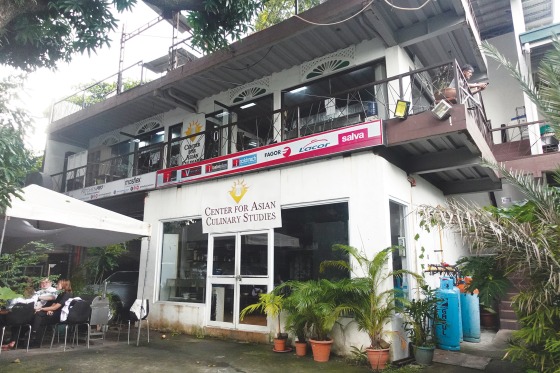グルメ大国が肩を並べる東南アジア。もちろんフィリピンもその例外ではありません。とても多様性があり、知れば知るほどフィリピン料理に魅了されます。そんなフィリピンの食文化をより深く理解すべく、有名シェフ、ジーン・ゴンザレスさんにフィリピン料理の奥深さ、そして熱い思いを語っていただきました。
Every Southeast Asian country is proud of its food culture. So is the Philippines. A rich food culture has developed in this country with geographical and historical influences. A renowned Filipino chef, Eugenio “Gene” Gonzalez talks about Filipino cuisine and his passion for culinary arts.

ジーン・ゴンザレス さん
Chef Eugenio “Gene” Gonzalez
カフェ・イザベルオーナーシェフ。
Center for Asian Culinary Studies校長。
パンパンガ州スリパン出身。
食通の家庭で育ち、5歳からキッチンに立つ。
大学卒業後、銀行員として働くが料理の道に惹かれ、23歳の時にカフェ・イザベルをオープン。
現在、息子と娘も調理師となり、 料理人一家となりつつある。気持ちのこもった料理を愛する。
Chef, restaurateur, and founder/president of Center for Asian Culinary Studies
Born and raised in a food-passionate family in Sulipan, Pampanga,
Chef Gene started to cook in the kitchen when he was five years old.
He opened Café Ysabel at the age of 23. His son and daughter also pursue the culinary path.
He likes food prepared with care.
多彩なフィリピン麺料理
かつてフィリピンでは「麺料理=メリエンダ(おやつ)」という認識が主流でした。それはフィリピンに深く根付く米食文化が強く影響しています。しかし今ではメリエンダとしてだけではなく、食事としても楽しまれるようになってきました。
麺にもさまざまな種類があって、ライスビーフンや、パラボクなどに使われる白色透明な太い米麺、そして中華スタイルの小麦からつくる麺もあります。麺料理に対する意識の変化は、フィリピン人が旅行や就労などを通して、それまではなかった文化を海外から少しずつ取り入れるようになったことが起因しています。
麺料理を食事として受け入れるようになった中でも、ライスヌードルが好まれがちなのは、フィリピン人の米好きをよく象徴していると言えるでしょう。例えば、パンシット・パラボク、パンシット・マラボンそしてパンパンガ州のパンシット・ルグルグはそれぞれ異なる麺料理ですが、すべて共通してライスヌードルが使われます。ルグルグとパラボクはどちらも同じオレンジ色のとろりとしたソースがかかっていても、麺の太さが違います。一方は細いビーフン、もう一方は太麺です。またルグルグやパラボクにシーフードなどのトッピングをふんだんにのせればパンシット・マラボンになるのです。
シェフのおすすめローカル麺
マニラ市キアポにあるクインタマーケットのパンシット・パラボクはぜひ試してほしい。イカ墨ソースで和えたイカがトッピングされたパラボクがあります。また日本の人には、スープ麺のロミをおすすめします。うどんに似ていますし、アジア全般で好んで食べられているスタイルの料理なので、食べやすいのではないでしょうか。
地域性豊かな食文化
麺料理に限らず、フィリピン料理はバリエーションが豊富。海に囲まれ、7000以上もの島があるという地理的特徴から、調理スタイルに地域差が大きく表れています。魚料理のキニラウもミンダナオ地方とルソン地方中部のケソン州のものでは全然違います。なぜなら獲れる魚の種類も違い、使う酢にも違いが出るからですね。
不思議なのですが、多くの人たちが自分の地域の郷土料理を他の地域の人にはあまり提供したがらないんですよ。他地域の料理のことを知らないがゆえに、自身の作る料理はあまりにも一般的過ぎて人に出すのは恥ずかしいと思い込んでいるんです。実際は他の地域の人にとっては珍しく、とても興味をそそられるのですが。
東南アジア料理は紙一重
実はフィリピンも含めた東南アジア諸国の料理には、共通性があります。それぞれが自分の国の料理はユニークだと思っています。しかし、よく見てみると、小さなカニや発酵米などの共通した食材が好まれて使われていて、ただ調理スタイルがほんの少しずつ違うというだけだったりするんです。これはフィリピン国内でも共通していえることで、地域独自の調理スタイルが、他とは違った味を生み出します。
時代に伴う料理の進化
昔は今ほどフィリピン料理にバリエーションがなく、カレカレはこう、ポークバーベキューといえばこれだ、と言い切れるほどシンプルでした。しかし現在はさまざまなニュアンスが入り混じってきていて、フィリピン料理の幅が広がっています。これは間違いなくインターネットが普及したことでレシピ共有などが可能になったことによる影響であり、食に対する視野が広がったといえます。斬新な創作料理も増えてきていて、私自身もじゃがいもの代わりにウベをフレンチ料理のスープに使ってみたりと、フィリピン料理や食材のポテンシャルを試し続けています。
フィリピン料理の発展に貢献し続ける
私は23歳でレストランを始め、その後イタリアとフランスのレストランで修行をしました。その他にも世界各国を旅しましたが、そこで気が付いたのは、自分の国に学ぶことがたくさんあるということ。また教育が大切であることも実感し、若いシェフたちに自分の経験を伝えるようになりました。それが料理学校の設立につながり、フィリピン料理をもっと世界に広めたいという思いから、世界各地の料理イベントに参加したり、SNSで活動したりしています。

カルボナーラパスタ
Bacon Steak with Carbonara
さまざまな味を求めて出かける楽しみ
やはり「バリエーションの豊富さ」は間違いなくフィリピン料理のアピールポイントです。ルソン、ビサヤ、ミンダナオの地域や島によって食材や調理法、調味料が全く違います。そうなれば同じ料理でも味は変わってくる。皆さんがマニラからどこか地方へ訪れた時には、ぜひ地元の人たちにローカルフードについて尋ねてみてください。どの地域でも必ずその地元で有名な料理、そしておいしいレストランを見つけることができるでしょう。

毎週金曜日午後6時からのタパスビュッフェ(1人830ペソ。要予約)
Friday Tapas Buffet starts at 6pm (830 pesos / pax, reservation required)
Tasty Local Specialities Throughout the Philippines
Various Filipino Noodles Dishes
Filipino noodles were considered more of a merienda before, as we have a rice-eating culture. However, a lot of noodles are stylized now and have become proper meals in themselves.
You can choose the texture of noodles, such as rice bihon, thick noodles used for palabok or malabon, or Chinese style flour-based noodles. Many Filipino traveling and working abroad have brought other cultures into the Philippines. As a result of it, it has facilitated the progress of noodles dishes and culture in the Philippines.
We still appreciate rice culture by eating rice noodles. For example, pancit luglug, pancit palabok, and pancit malabon are all made of rice with some different features.
Chef’s Recommended Local Noodles
In Quinta Market, Quiapo, Manila, there is a restaurant that serves excellent pancit palabok topped with fried squid tossed in squid ink. Lomi is a must-try for Japanese noodle fans. It has a texture similar to udon.
Rich in Regional Food Culture
As the Philippines spans over 7000 islands, regional cuisines reflect the
culinary landscape. Kinilaw, a marinated fresh fish dish, varies in Mindanao and Quezon province because different species of fish and different types of vinegar are used. The interesting thing is that people in the regions are embarrased and hesitant to serve their food to visitors from other provinces. Because they believe their food is too ordinary and boring for them. However, it is unique to the region and enthralling to visitors.
Common Ingredients but Different Tastes in Southeast Asian Cuisine
We have some ingredients in common. Southeast Asians believe that their cuisine is distinct from other SE Asian cuisines. However, if you look closely, you will notice that the same ingredients, such as small crabs and fermented rice, can be found on most SE Asian tables. The same is true for Filipino regional food. Similar ingredients are used but cooked in different ways.
Changes in Filipino Cuisine Then and Now
There was a time when Filipino cuisine was stagnant. Everything was standard. But now, there are a lot of nuances and differences that excite you. I believe the Internet has played a significant role in these changes. It has begun to become dynamic as new food varieties are introduced. I also made innovative dishes, such as vichyssoise soup made with ube instead of potatoes.

ミートボールパスタ Meatballs
Contribution to the Progress of Filipino Cuisine
After traveling around the world and working in restaurants in Italy and France, I realized there are so many things to learn in my own country. People require a lot of education. As a result, I made a decision to open a culinary school and train young people. I want to spread Filipino cuisine all over the world. I am now contributing to the Filipino culinary industry by attending food festivals or events in the world and sharing my knowledge and experience on social media.
Filipinino Cuisine is “Diversity” and ”Discovery”
Filipino cuisine comes in a wide variety of styles. It speaks of islands and the various aspects of what they have. Everywhere you travel in the Philippines, you will find there is a distinct culinary style. If you have a chance to visit other provinces from Manila, I guarantee that you will find one restaurant that is well-known in the area and serves good food.
175 M.J. Paterno, San Juan City, 1500 Metro Manila
● 営業時間
火~木、日:11am–9pm / 金、土:11am–10pm
※ 月曜日定休

Center for Asian Culinary Studies


















